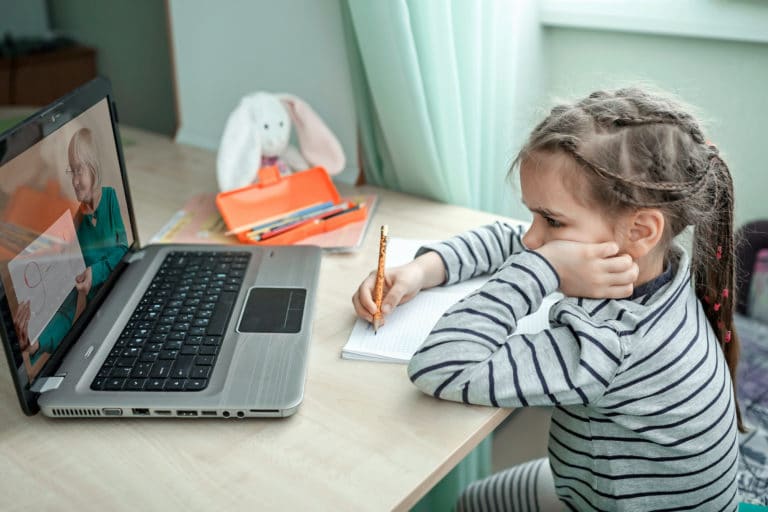
Class is the next generation virtual classroom for K-12, higher education, government agencies, and the workplace. Contact us today to schedule your live demo and see Class in action.

Class is the next generation virtual classroom for K-12, higher education, government agencies, and the workplace. Contact us today to schedule your live demo and see Class in action.

“What is the future of…” is a phrase that can be applied to a lot of things today as organizations and professionals contemplate the things they have learned during the pandemic and how these learnings may fuel future activities.
Education is no exception to the rule. As K-12 virtual learning became the norm during the pandemic, administrators, educators, students, parents and others all began contemplating the future of online learning. What does K-12 virtual learning look like in the future? What will it look like when classes resume this fall?
While vaccinations and a decline in COVID-19 cases have the potential to drive more in-class and in-person learning during the 2021-2022 school year, it is likely that some form of virtual or online learning will still be in play. We asked educators, administrators and education experts for their perspectives on the issue and what they believe the future of K-12 virtual learning will hold.
Margaret Choi is a teacher with CodeWizardsHQ which has been teaching students from 8 to 18 online exclusively for more than five years, well before the pandemic. “Virtual learning is still in crisis mode,” says Choi. It hasn’t been a simple switch for anyone, she says—teaching in-person and teaching online is not the same thing. “In the same way that retailers had to rethink and rebuild the methods used to reach customers, teachers need to rethink their strategies as they attempt to interact with their students in a digital environment.” As they look to the fall and beyond, Choi recommends:
Lee Wilson is a consultant and ed-tech industry expert with VEDAMO, an online classroom platform. Today, says Wilson, schools know they can make the leap from traditional to digital classrooms successfully. “At all levels of the school staffing ecosystem, employees have gained the technical training and experience to continue teaching remotely when required, and most students have the equipment needed to connect remotely.” As schools move farther away from panic response mode, they are beginning to create more thoughtful approaches to K-12 virtual learning based on what they learned during the pandemic.
As they look ahead to fall, educators see the opportunity to leverage what they have learned over the past several semesters and apply best practices to both in-class and virtual classrooms. They no longer have to ask, “what is virtual learning?” Virtual schooling has become commonplace, and experts say it will likely continue to have a place in 2022 and beyond.

What is the biggest takeaway from educational experts’ perspectives? The “new normal” is anything but.
“Every day the VEDAMO team talks to educational district leaders and administrators at the K12 level. In conversation after conversation we are hearing that their school systems will still need to teach a number of students virtually moving forward into 2021 and beyond,” says Wilson. This, Wilson says, “is a complete sea change from the pre-COVID landscape when virtual learning was not a universally accepted practice.”
Eric Kim, co-owner and program director of LA Tutors, an international private tutoring company, says that while many families are eager to return to in-person learning, virtual learning in some format or another is here to stay.
James Bacon, director of outreach and operations at Edficiency, an automated educational scheduling software service, has been a teacher, district administrator, and school consultant and coach, working in districts as few as 500 students (Tensas Parish Schools) to those with almost 150,000 students (Charlotte Mecklenberg Schools), and everything in between. He agrees that virtual learning or classrooms, in some fashion, are here to stay.
“While we’re seeing most schools plan to return primarily in-person for the fall, I believe that many districts will be forced to continue some kind of virtual option for students, mostly because some families liked the flexibility and option to learn at their own pace,” Bacon says. “To not lose students, and subsequently their funding, I think that some larger districts with multiple schools at each grade level will offer some virtual options through a centralized program to get some economies of scale from their teachers, platforms, and systems. Ideally, teachers in these larger districts will not have to support a mix of in-person and virtual students.” He’s already seeing some interesting virtual learning models emerge. For instance:
A few schools in the Salt Lake City area have implemented “flex Fridays” where students do not have to come to school in person unless they are requested to by a teacher or choose to themselves. They can even come for only one or two periods and leave for the remainder of the day to learn virtually from home.
Another school in Georgia is currently talking to Class about helping them schedule a third of their students to be on campus for hands-on, choose-your-own-adventure style learning aligned to a STEM career path, while the other two-thirds of the campus stay at home to work virtually each Friday.
“These models I think will start to grow in popularity over time as we have some schools that start to see success and show other schools what it can look like to creatively and intentionally build partially virtual options into the regular schedule,” Bacon says.
EdWeek recently reached out to school leaders and education experts in a survey to better understand what K-12 virtual learning may look like in the future. While much is still “in a state of flux” some common themes emerged. For instance: “Nearly 70 percent of districts plan to offer a ‘much wider array’ of remote options next year.” EdTech reports that a “fall 2020 RAND survey of district leaders found that 1 in 5 schools have already adopted or plan to adopt virtual schooling after the pandemic.”
The state governments are also getting into the mix. In Nevada, for instance, “a bill inspired by the Blue Ribbon Commission for a Globally Prepared Nevada would compel all districts to make a plan for virtual education and ensure students have access to technology,” according to the Las Vegas Sun.
The bottom line: virtual learning in some form is likely here to stay at all levels of education long after the pandemic is deemed “over.”
“Teachers and students alike have found that virtual learning offers some significant benefits, especially in the private sector, and many families and students now prefer this method,” Kim says. What’s most important, he says, is that families and schools alike have come to appreciate the convenience of remote learning and the many benefits it can offer.

Class is the next generation virtual classroom for K-12, higher education, government agencies, and the workplace. Contact us today to schedule your live demo and see Class in action.

Class is the next generation virtual classroom for K-12, higher education, government agencies, and the workplace. Contact us today to schedule your live demo and see Class in action.
Get our insights, tips, and best practices delivered to your inbox

Sign up for a product demo today to learn how Class’s virtual classroom powers digital transformation at your organization.

Features
Products
Integrations